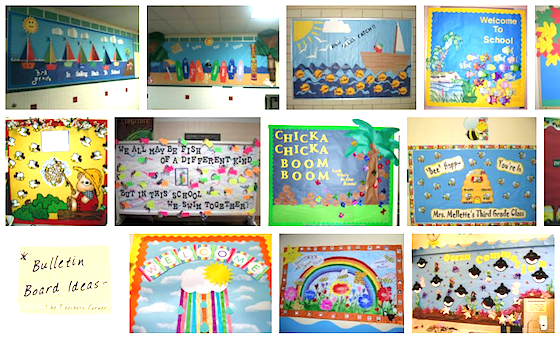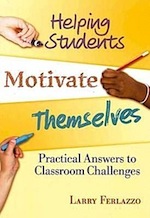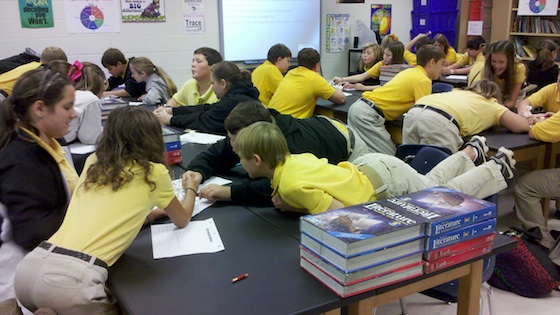
If you’re an educator and you’re even remotely connected through social media to your professional world, you know that there is a tremendous amount of dialogue back and forth about educational change. It’s happening on Twitter, via blog posts, through online community discussions and even on Facebook.
Particularly during the summer we blog and talk and write and tweet, and even pin. We share amazing ideas with each other about how things need to be different and what we wish was happening in schools to better prepare our students.
And then we go back to school, and what happens?
Certainly, at the very least, we might expect that those great games, beautiful bulletin boards, and wonderful classroom arrangements seen on Pinterest are used to transform the classroom into a welcoming (albeit teacher-created) space for students to start the year.
That’s likely happening in some classrooms. But how many people really are able to make any of the meaningful changes we’ve talked about all summer long? With the realities of testing and the scripted programs that are overtaking our schools, I’m sure many teachers are feeling that their hands are tied. But that’s not actually true.
Here’s how you can change some things
Simple steps like changing the focus of your back to school night or giving kids the opportunity to self-select books on their own levels, as shared in The Book Whisperer (a great read if you haven’t already done so), are great ways to start transforming your room from teacher centered to student centered. As you’re rewriting your units to better align with the Common Core, why not take a closer look at the TPACK model and see how you can meaningfully incorporate one technology tool into your teaching. You don’t have to completely turn your teaching life upside down to start making the change that’s desperately needed. One small voice and a few small steps can get the ball rolling.
But it’s going to take more than changing how you do “stuff.”
But it’s also about changing our mindsets
It doesn’t matter how nice your classroom looks or how much technology you use, you’ve got to make sure you’ve also changed your attitude – your teacher mindset – if you really want to make your classroom a transformational environment for your students.
If you’re a teacher, you’ve probably heard others lamenting about their students in the hallway, in the office, in the workroom, in the lunchroom. While some discussions are those funny, ha-ha stories that need to be sent in to Reader’s Digest (because kids just say the darndest things), more often than not these conversations take on a negative tone. How many of you have heard statements like this:
 These kids can’t follow directions to save their lives!
These kids can’t follow directions to save their lives!- At least my Period 1 class knows what they’re doing. My 2nd period group is clueless!
- <insert name here> is a mess.
- It sure would be nice if these parents would take care of their kids.
- This student doesn’t belong in my room. Why isn’t he / she in the resource room / emotional support / learning support?
- Those kids are so slow they can’t even put their materials away the properly.
- I don’t know why we’re even bothering with <insert name here>. He / She will never get it.
- <Insert name here> is going to make a great janitor when he / she grows up.
- Ugh – time to go deal with my low class.
- I don’t know that name – it’s not MY student.
I could go on, but you get the point. No matter how much people claim to love teaching and claim to love students, if individuals are making statements like these I think it’s time to question why they are still in the classroom. These are perfect examples of how individuals can make their classroom as pretty as they want or add as much technology as they like and still fail their students because of their teacher mindset.
For some time now I’ve been interested in the work of Carol Dweck, and in conjunction with my district’s implementation of the Common Core Standards we began our year last August with a professional development day that combined the idea of a fixed vs. growth mindset and a consideration of how we differentiate for our students in the classroom. While I have been very vocal about the fact that most professional development days are a huge waste of time (I often say I can learn more in a one hour Twitter chat), this PD was different. I was engaged and I learned a lot because the topic was meaningful to me.
 Unfortunately, I can’t say the same for many others who were present a year ago. If you’ve looked at any research about the adoption of new ideas, there’s always going to be the innovators that are ready to go and those that lag behind. But what about the ones who aren’t moving forward at all?
Unfortunately, I can’t say the same for many others who were present a year ago. If you’ve looked at any research about the adoption of new ideas, there’s always going to be the innovators that are ready to go and those that lag behind. But what about the ones who aren’t moving forward at all?
When our kids’ futures are at stake can we really afford to be individuals with a fixed mindset? Can our kids really afford to spend a whole day, a whole semester or a whole year with individuals who have fixed mindsets? Who obsess on the deficits and ignore the strengths? How will that impact young developing minds? I think we know.
We need to transform . . .
The beginning of a new year is a great time to make some changes. We can work on ourselves, and we can work to find the courage to speak out about the large negative impact those with fixed mindsets are having on student and school success.
Just like implementing changes in our classrooms, changing our mindsets can start with baby steps. Of course, like any worthwhile change, even baby steps can come with some scrapes and growing pains and challenges, but in the end it will be worth it. What follows are some of my suggestions for moving forward.
1. Build and utilize relationships with students
A common fixed mindset complaint focuses on motivation. It’s not unusual to hear educators say, “If these kids would just put in a little bit of effort they could achieve so much more.” In his book Helping Students Motivate Themselves: Practical Answers to Classroom Challenges, Larry Ferlazzo spends the entire first section talking about establishing classroom culture and building relationships with students. How can relationships improve motivation? Very simply, students will work for you if you show them the value in what they are learning and they know you care.
 What are the baby steps that you can take to develop relationships? A simple one is to greet your students each day as they come into your classroom. As you say hello, ask them how they’re doing or what they did the night before. It may not seem like much, but a simple, “Hello! How was your night last night?” shows the kids that you think what happens to them matters. It opens lines of communication, plants the seed for a relationship, and gives you knowledge that you can use to connect new learning to their lives.
What are the baby steps that you can take to develop relationships? A simple one is to greet your students each day as they come into your classroom. As you say hello, ask them how they’re doing or what they did the night before. It may not seem like much, but a simple, “Hello! How was your night last night?” shows the kids that you think what happens to them matters. It opens lines of communication, plants the seed for a relationship, and gives you knowledge that you can use to connect new learning to their lives.
While our hands may be tied in terms of the curriculum we must teach, creating lessons that incorporate our students’ interests will help with motivation and allow them to make connections to the work they need to do. As you’re building relationships with your students with greetings and quick check-ins, you’ll get to know what they like to do outside of school, who their friends are, and the things that are important to them. This is information you can use in your lessons and assignments.
A great way my teammates and I do this is by putting our students’ names and things they love into the problem solving that we do in math. It may sound a bit hokey at first, but you’ve never seen a fourth grader get more excited about creating a data table until it’s about them and how long it’s going to take to buy their favorite video game!
Reading becomes more exciting when you select books focusing on topics your students’ enjoy or allow them to select their own books for independent reading. The same is true for writing: your student may not have any interest in writing until they’re allowed to write about something that matters to them. And studying the regions of the United States suddenly becomes more interesting when the student can learn about the state where his or her favorite sports team is located or relatives live.
Building relationships with students helps teachers move away from the fixed mindset and into a growth mindset because we can see each child as more than just one number on a list or one label in a school support menu. We can start seeing the whole picture of that child and make connections with him or her that make learning more accessible.
2. Recognize students’ gifts and effort
Building relationships with students also helps us begin to recognize the little things that make each of our kids unique. While individuals with a fixed mindset often view “being smart” as something you either have or don’t have, individuals with a growth mindset believe that intelligence is something that we can cultivate and invigorate.
 As you develop relationships with your students you start to find out each one’s strengths. As teachers we need to actively seek out our students’ gifts, whether they be academic, athletic or artistic, and incorporate them into lessons and assessments to help our students see that their potential is not limited by a label or a score when it comes to learning new things. We need to begin a process of appreciative inquiry.
As you develop relationships with your students you start to find out each one’s strengths. As teachers we need to actively seek out our students’ gifts, whether they be academic, athletic or artistic, and incorporate them into lessons and assessments to help our students see that their potential is not limited by a label or a score when it comes to learning new things. We need to begin a process of appreciative inquiry.
The key to recognizing gifts is to stop putting your kids into categories like smart and dumb or high and low. If we each take a close look at ourselves we have areas where tasks are challenging. For me, it’s visual / spatial work – I have an extremely hard time looking at a net and telling you what a solid would be. Does that mean I’m not smart? No! It just means that I’ll need help with those tasks, and I’ll shine in other places. Our students are the same way. Instead of one overarching label, we need to provide supports to our kids for their areas of weakness and let them shine by incorporating their strengths as often as possible.
And whether students are working to the best of their abilities to showcase their strengths or they are going out on a limb and trying something outside their comfort zone, it’s essential that we honor their effort and focus on mistakes as opportunities to learn.
3. Create opportunities for collaboration
It breaks my heart to hear nine and ten year olds say, “But we can’t work together, that’s cheating!” Or, “But we can’t uses calculators / computers / books because that is cheating!” Working and living in the adult world is all about collaboration (or should be). Take one moment and think about your job as an educator. Think about your spouse’s job, your friend’s job, or other positions with which you are familiar. How many of those positions require an individual to work in complete isolation? Honestly, I can’t think of one. Yet we consistently require our students to do their best work without any opportunities to talk through their ideas, get input, and make changes for improvement.
Collaboration has its naysayers. “But it’s loud! But the kids will be unfocused! But work will not get done when I want it to be finished or how I want it to be finished! But it’s messy!”

All of those “buts” are correct. I’d like to add another one. But you will be amazed at what your kids can do when given the chance to collaborate. Certainly any type of collaboration takes some training. You have to help the class understand how to work together as a team, and you have to provide the training for the tools you’d like them to use. It’s also essential that you provide a rubric so the students know what the goal is for their tasks.
Finally, you have to think carefully about making timelines and the amount of work you want completed during that time. This one is the biggest struggles for me, but I’m finding that the more projects we do, the better I’m getting at this. I’m not saying that following those steps will make collaboration perfect, but I think you’ll be amazed at all of the positives that can come from these collaborative situations. Kids can create projects to teach others about their home state. Or maybe they can demonstrate what they’ve learned about a scientific process without you even saying a word. Honestly, the sky’s the limit with what they can do!
4. Reflect upon your practice, don’t blame the kids
One thing that dawned on me during that inservice day in August and keeps coming to the forefront in my daily experience: The fixed mindset comments from teachers often place blame on the students. It’s much easier for a teacher to say, “Ugh! These kids didn’t learn anything I taught them about place value!” rather than saying (or admitting), “Ugh! My instruction just was not right for my students. I need to try something different!”
If we truly want to transform ourselves into people with growth mindsets, we need to stop placing the blame on all of our students and start taking a look at whether our instructional practices are relevant to our students. As the adults in the situation, we have to take responsibility when the students in our charge are not gaining the skills they need to be successful. Because here’s the thing – these same kinds of kids are doing GREAT in classes with other teachers who have made the shift.
 When we see that our lessons repeatedly aren’t working, we need to take the painful step of admitting that the practices we have been using for 2, 5, 10 or 20 years are not the best fit for our current group of students. We have to be willing to seek out our own personal professional development if it’s not being provided by our districts or boards so we can best meet our students’ needs. Perhaps this means joining Twitter and talking with other teachers to see what works for them. Maybe you take a look at some teachers’ blogs to learn about how they teach a given subject. Or you might even find a course to really transform your teaching to be a better fit for your students.
When we see that our lessons repeatedly aren’t working, we need to take the painful step of admitting that the practices we have been using for 2, 5, 10 or 20 years are not the best fit for our current group of students. We have to be willing to seek out our own personal professional development if it’s not being provided by our districts or boards so we can best meet our students’ needs. Perhaps this means joining Twitter and talking with other teachers to see what works for them. Maybe you take a look at some teachers’ blogs to learn about how they teach a given subject. Or you might even find a course to really transform your teaching to be a better fit for your students.
Replacing chalkboards with Smartboards — replacing writing journals with laptops — replacing stacks of flashcards with iPad apps will all thrill our kids, temporarily, and get them using technology. Hanging pretty posters and making our room look inviting will certainly help kids believe that they are welcome and entering a fun and inviting place at the beginning of the year.
But if we truly want our students to be successful, and if we truly want our classrooms to be the places where powerful learning is always going on, then we all have to make sure that while we are changing the “stuff” we are also changing and transforming ourselves.
We need to refresh our teaching life.
Becky Bair
Latest posts by Becky Bair (see all)
- Changing Our 'Stuff' Is Not Enough - August 29, 2013
- Connected PD on a (Zero) Budget - June 26, 2012
- We Always Care about Kids at Testing Time - March 26, 2012


Terrific post Becky! I am totally with you on the mindset to create significant personal change. Most students, when asked, can list qualities of their teachers. Not many, however, are able to describe how their teachers learn. I think that part of the relationship building is allowing students to see how educators learn, particularly those instructors who embrace collaboration and reflection. We need to let go of the “stuff” the contributes little or nothing to learning. Thanks for sharing these essential points.
Thanks so much for your comment, Robert! My teammates and I talk with our kids so much about the strategies that work for us and how different strategies will work for different people. We do it in the context of “helping kids learn strategies” and we collaborate, team teach and do self-reflection all of the time in front of the kids. But I never stopped to think that it’s not just modeling, it’s another way we connect with the kids and help them get to know us. Thanks so much for pointing that out. And when you said, “We need to let go of the “stuff” that contributes little or nothing…” I completely agree. It’s time to stop with the comfortable and easy and find what works best for kids.
Hi, your article has many significant points that teachers need to be reminded of once in awhile! I couldn’t find your copyright terms on the site but I was wondering if I could make a copy for a newsletter I edit? The newsletter is for a non profit teacher organization, British Columbia cooperative learning association. It goes to about 200 teachers in bc, Canada. Please email me if its ok. Thank you!
Hi Erica! I’m glad you found it helpful, and I sent an email your way. I hope you’ll let me know how the teachers respond if you hear any feedback.
Great article! Especially point 4. It’s tough to admit sometimes but if our classroom is a mess it’s because we’re doing something wrong and we need to fix it. Acknowledging this is the first step towards improvement
Linda, you certainly hit the nail on the head when you said, “It’s tough to admit sometimes but if our classroom is a mess it’s because we’re doing something wrong and we need to fix it.” Here in Pennsylvania we are starting a new evaluation system, affectionately called MME (short for multiple measures evaluation), and the reflection piece is a huge part of what we teachers are supposed to be doing now as a natural part of planning. While some are leery of the new system, I’m hopeful. I’m hoping that the requirement will encourage those who were the blamers will now start looking more carefully at themselves, and I’m hopeful that it will make our evaluation system more of a growth model. When a lesson doesn’t go well, that’s what it gives us: an opportunity for growth, if people choose to look at it that way.
Yes, yes, yes!! Thanks so much for sharing. Wonderful post and spot on. As I’ve reflected over last year many of the things I felt my kiddos didn’t “get” or “do right” was a teacher issue, not a kid issue. I hadn’t modeled or encouraged it enough. Hoping this year to make sure I’m not placing blame on my students for things I’ve failed to teach them.
You’re welcome, Leigh Anne! Believe me, I know how hard it is. I think many of us teachers have a perfectionist personality so it’s terribly hard to admit or recognize that something didn’t go well. But we really have to get past that need to be perfect (a need that’s fueled externally by unrealistic, high stakes testing situations and punitive merit pay evaluation systems) and focus on how we can adjust lessons to meet the kids’ needs. Those times where I’m trying to figure out what else I can do are the times when I value my PLN most because that’s where I get my new ideas to try with my most challenging learners.
What an awesome post! I’m facilitating a training next week and the concept of appreciative inquiry is PERFECT. Thanks again for sharing!
Thanks, Angel! Appreciative inquiry is so interesting to me because it is completely the opposite of what we do in our school. We take kids and force them to repeatedly practice those skills in which they are weak. Perhaps if we found out what our kids (and their teachers!) love and what they are passionate about we could use these passions and strength to help them develop the areas of weakness. I’m wondering how we as teachers can start facilitating this shift on a wider scale in our schools, especially in this age of “needing to pass the test”.
It is always a good idea to freshen our minds with positive thoughts to keep the passion for teaching alive. It is always an educators goal to strengthen their students learning and to minimize their weaknesses. Such a good reminder.
You make such a good point. With so much negative being thrown at teachers in terms of testing, reduced funding, and attacks on pensions and our profession it is vital that we all stay positive. It really is the only way we are going to be able to keep teaching our passion. Thanks for joining in the conversation!
Hi Becky,
Although I found the majority of this article to be insightful…the bullets you on hallway chatter was destructive in my opinion…as an educator we spend most of our time in the classroom or outside our classroom doors monitoring traffic as students pass from one period to the next.
I have personally never heard my colleagues “teachers” ever make those type of comments. Of course I’m sure it may happen, I just feel it’s actually counterproductive to fuel the fire of those whom have little to no experience in education.
V/R Don J. Fessenden, Founder
TeachersMeet.com
Thanks so much for joining our conversation, Don. First of all I need to say how thankful I am that you have never heard your colleagues’ teachers make the comments I referenced in the beginning of the post. Clearly that means your experiences have been around those who are professional, keep the comments to themselves, or have already shifted to having a growth mindset about their students.
Sadly, I deal with comments like these from my colleagues, all of whom have many, many years of classroom experience, every day. What I am trying to do by drawing attention to them here is bring to light the fact that making comments like this is not funny. It’s not helpful, and it’s not, as I feel some may believe, an acceptable form of “venting” after a tough day. Comments like this are a verbal representation of the type of fixed mindset our students can little afford to be exposed to day after day. It’s my hope that the teachers who read this will begin to understand that words become actions; if we continue to say these things, even in a joking / blowing off some steam manner, then our actions will begin to reflect how we talk. If we really “love kids” and “love being a teacher” then it’s time for this to stop.
Thanks for questioning why I chose to include that section.
I love Carol Dweck and her growth mindset model. Thank you for your take on’ how to motivate your students and improve your relationship with them to allow growth’. My take back from every discussion is tools for secondary – so here is my question to all of us – who teach older kids- how to connect with the when they share limited information on their likes and hobbies? How to connect with them as a mentor during registration time when you do not teach them a mainstream subject?
This is a great question, Vandana. Since I work with younger kids (8, 9, and 10) who are almost always willing to share I’ve sent this out to Twitter to see if we can some suggestions for making those connections with older kids. I feel like introducing yourself and telling the kids a bit about you is a great way to start – if you trust them enough to share your stories then I believe they will share with you. But I may be way off so we’ll see what others have to share.
Hi, Becky – I really appreciated your helpful and insightful comments. I would love to share your remarks with the educators at our school in our newsletter. Would that be possible? Thank you!
Thanks, Bev! You may absolutely use the article. Please just provide proper credit and a link here to the original page. I hope you’ll come back or have your teachers come back and join in the conversation with their thoughts after they read it.